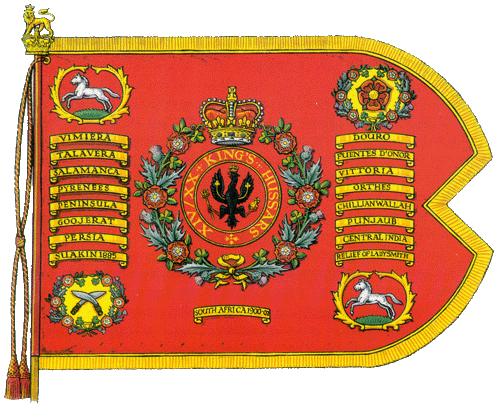
British Hussars (Home) Sword Sales For navigation links to various hussar regiment pages, see below
The 14th/20th King's Hussars |
 |
The 14th/20th Kings Hussars was founded in 1922 through the amalgamation of the 14th Kings Hussars and the 20th Hussars and was renamed the 14th/20th Hussars and given the title 'Kings' after George VI came to the Throne on the 14th December 1936. On the 16th December 1936 the Regiment was notified that it was to be re-designated as the 14th/20th King's Hussars. This was achieved by representations being put forward by the Colonel of the Regiment General Sir George Barrow. The newly founded Regiment had its first tour of active duty in Egypt in 1931 for two years. The last time the Regiment went out mounted was in January 1938, this was on manoeuvres near Lucknow.
Without ceremony the Regiment said goodbye to the horses in August 1938 and became fully mechanised. Each officer was allowed to keep one horse, a pool of horses were also kept. Tanks arrived in two and threes (The Vickers light tanks MK2 and the MK6), and on the 31st March 1939 the Regiment was officially recorded as being converted to mechanisation. All ranks were transferred from Cavalry of the Line to the R.A.C at Secunderabad, on the 11th April 1939. The Regiment has maintained all its Cavalry traditions throughout the transition period and to it's end.
The Regiment served in Iraq and Iran during the middle of 1941, German forces were becoming more influential in the area at the time and the Regiment was tasked to counter those heavy influences. The Regiment formed the main element of the second light Armoured Brigade providing the only tanks available in the area. In Mesopotamia the Regiment went through several changes, it had several new types of Tanks issued to it culminating in the issue of the MK4 Sherman tank. The Regiment spent the best part of the next three years in the middle east protecting the oil fields and maintaining supply routes. Then it was Italy, it was here that the Regiment fought the Germans during the advance on Bologna, Medicina was a well fortified and protected area. 'A' Squadron were dispatched in the newly acquired 'Kangaroo' vehicles to deal with the problem. A long battle ensued resulting in the defeat of the Germans and the 'Medicina' battle honour being added to the Regiments Guidon. Finally the Regiment took part in the Battle for the Gaiana Canal before withdrawing for a refit and the final charge to Padua in 1945. |
 |
The post war years.
The Regiment had a short spell on Armoured cars in 1945. In 1946 they arrived in Germany and were issued the Archer tank destroyers within the 53rd (Welsh) Infantry Division. After three years in the United Kingdom the Regiment was sent back to the Dessert , Libya, and tanks, firstly on the Comet and then the Centurion Tanks. Three after that it was to Europe and Münster in Germany, they were the Armoured element of the 20th Armoured Brigade. In 1957 the Regiment was on the move again but the Regiment was split into two with A & C Squadrons remaining in Munster on the Saracen, whilst B Squadron moved to Berlin to become the Berlin Armoured Independent Squadron.
In 1962 they returned to Libya once again with Ferret Scout cars, also completing two tours in Cyprus. 1965 and the Regiment moved to Paderborn, Germany. It was here in 1969 that HRH Princess Anne became the Regiments Colonel-in-Chef and she remains so to this day.
Again the Regiment was sent all over the globe with HQ and C Squadrons going to Tidworth. A Squadron went to Singapore from 1970-71 prior to there early return to the United Kingdom and Tidworth. Those Squadrons based in Tidworth were deployed periodically to Northern Ireland. In 1973 the 14th/20th Kings Hussars moved to Herford, B Squadron being the last to arrive when their tour of Hong Kong ended late 1973. 1974 Saw the Regiment return to Northern Ireland. In 1976 the Regiment returned to the UK including Bovington, Lulworth and Warminster.
The Regiment returned to Germany with a long tour of Hohne in 1977 until 1984 during which time it completed a tour of Belfast in 1978-79. The Regiment split once again with the main part moving the Catterick as the Armoured training Regiment and B Squadron replacing the Queens Own Hussars as the Berlin Armoured Squadron. C Squadron replaced B Squadron in 1986 (it has to be said in name only) where they stayed until the wall came down and there need was no more in 1991.
The majority of the Regiment left Catterick and moved to Munster in 1988 and in 1991 it was deployed to the Gulf as part of the task force deployed to the Gulf region to rid Kuwait of the invading Iraqi army. The Regiment played a leading part in the land offensive as part of the 4th Armoured Brigades Dessert Rats in what was to be its final Battle Honour as the 14th/20th King's Hussars.
Once the war was over it returned and remained in Munster until amalgamation with the Royal Hussars (PWO) on the 4th December 1992
Regimental Battle Honours
Bologna / Medicina / Sambre / Italy 1945 / The Gulf War 1991
Read about: The 14th (King's) Hussars and The 20th Hussars
Related links on this site:
Other related Web Sites:
